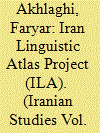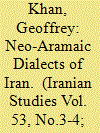|
|
|
Sort Order |
|
|
|
Items / Page
|
|
|
|
|
|
|
| Srl | Item |
| 1 |
ID:
179401


|
|
|
|
|
| Summary/Abstract |
Most studies on language contact in Iran have focused on the effects of Persian on the country’s minority languages. There are also many cases where large regional languages such as Azeri, Kurdish, Balochi, Lori and Bakhtiari exert an influence on smaller regional languages, and a few studies have appeared on this topic. This paper examines the effects of language contact in the city of Juneqan in Chahar Mahal va Bakhtiari Province, Iran, where the position of two minority languages—Bakhtiari and Qashqai Turkic—appears to be evenly balanced. The analysis is based on a comparison of L1 and L2 speech from two bilingual individuals with a different L1, as found in responses to the Atlas of the Languages of Iran (ALI) questionnaire. Drawing on examples from lexicon, phonology and morphosyntax, the article argues that the equivalent influence of each language on the first- and second-language speech of members of the other language community is likely achieved not by simple equal status, but through the counterbalancing of regional Bakhtiari dominance with majority mother-tongue Turkic population in this city.
|
|
|
|
|
|
|
|
|
|
|
|
|
|
|
|
| 2 |
ID:
179397


|
|
|
|
|
| Summary/Abstract |
This preliminary study explores the hypothesis that Arabic dialects spoken on the Iranian side of the Persian Gulf exhibit the beginnings of contact-induced shift in word order from VO to OV. Although the basic VO order is still stable, there is some variation even in this very limited data set. Specifically two phenomena point to a change in progress: clause-final copulae and auxiliaries that are placed after the lexical verb, lending further evidence to the observation that a clause-final copula is an areal feature of western Asia. The study also investigates semantic and pragmatic factors that influence word order choice, pointing to a strong effect of information structure in terms of narrow focus and theme-rheme partition. Furthermore, the study also reveals an effect of semantic role, specifically as far as the preferred placement of goals and recipients in post-verbal position is concerned.
|
|
|
|
|
|
|
|
|
|
|
|
|
|
|
|
| 3 |
ID:
179392


|
|
|
|
|
| Summary/Abstract |
The topic of “Endangered Languages” has come more into the focus of public and academic debate in recent years and is being discussed by numerous scholars. The Iranian languages are a branch of the Indo-Iranian languages, which are in turn a branch of the Indo-European language family. As of 2008, there were an estimated 150 to 200 million native speakers of Iranian languages.1 The Ethnologue (2019)2 estimates that there are eighty-six Iranian languages; the most prominent of these are Persian, Pashto, Balochi and the Kurdish group.
|
|
|
|
|
|
|
|
|
|
|
|
|
|
|
|
| 4 |
ID:
179395


|
|
|
|
|
| Summary/Abstract |
This paper explores the application and non-application of final /n/ deletion in Ghayeni Persian. In this dialect, final /n/ deletion is a productive phonological process whose application in different domains and environments is affected by several opaque counterbleeding and counterfeeding interactions as well as bleeding. This research presents new empirical data about these aspects which could be of general theoretical interest. It is also an attempt to make a contribution to current debate in phonological opacity. In so doing, it adopts Harmonic Serialism (HS) to accommodate counterbleeding opacity. It offers an analysis to survive a pitfall challenging HS in handling counterbleeding opacity in derived words. With regard to counterfeeding opacity, it adopts Parallel Optimality Theory (POT) using Local Constraint Conjunction (LCC). It discusses how POT and HS in particular could treat opaque interactions in Ghayeni dialect. In addition, this paper argues that a candidate which undergoes the same process twice in the same step could also be included in HS’s gradualness condition.
|
|
|
|
|
|
|
|
|
|
|
|
|
|
|
|
| 5 |
ID:
179398


|
|
|
|
|
| Summary/Abstract |
This article describes a dialectal variant of the Georgian language in Iran, Fereydani Georgian, which has survived in Iran for about 400 years. Various relevant aspects of the history and research on Fereydani Georgian are analysed. The choice of topics and sources focuses on previously unknown or, for the English-speaking reader, inaccessible authors. Since 2009, a large part of the linguistic data has been collected in several field studies in Fereydan. They serve as sources and show a revealing perspective on the origin, preservation and existence of the Georgian language island of Fereydani in Iran.
|
|
|
|
|
|
|
|
|
|
|
|
|
|
|
|
| 6 |
ID:
179402


|
|
|
|
|
| Summary/Abstract |
Iran Linguistic Atlas (ILA), funded by the Research Institute for Cultural Heritage and Tourism (RICHT), is a research project for mapping the linguistic diversity of Iran. The project is aimed at recording unified and comparable data from every spoken dialect of Iran’s rural areas and producing self-organized colored maps of this diversity using a specialized software program. Its initial phase began around the mid-1970s in the form of a joint project by the then Iranian Academy of Language and the National Geography Organization. In 2001, the documented data was handed over to the Cultural Heritage Organization, to be saved and expanded. The Iran Linguistic Atlas has now been redefined as an automatic linguistic atlas with the capability of producing self-organizing colored maps according to the operator’s choices. In this article, the ILA, its background and the state of its current phase is introduced. The nature of its data, its earlier and recent field methods, its audiotapes, digital databases and computer databases of phonetic transcriptions are described. In addition, ILA software program is presented and its capability for creating automatic colored maps is discussed thoroughly.
|
|
|
|
|
|
|
|
|
|
|
|
|
|
|
|
| 7 |
ID:
179393


|
|
|
|
|
| Summary/Abstract |
This paper describes and analyzes data from a number of Modern Iranian dialects spoken in Khorasan in the east of Iran which are unusual among the other Western Iranian languages in that they have grammaticalized a split tense-sensitive alignment in indexation, compared to other Iranian languages whose indexation splitness is sensitive to both tense and transitivity. These dialects are the former dialect of Birjand in the late nineteenth and early twentieth century, the present-day dialect of Ferdows, Khanik, and Se-Ghal’e. The findings are put in the context of the available data from the Classical Persian texts to show that the tense-sensitive splitness mentioned above is traceable in those texts. A number of external factors are discussed which seem to have been influential in the restructuring of the split-alignment of the former dialect of Birjand into a uniformly nominative-accusative alignment in terms of indexation as observed in the present-day dialect of Birjand. It is proposed that this restructuring is an instance of simplification. The three other dialects cited above are endangered in the sense that they can undergo the same kind of restructuring as happened to the dialect of Birjand.
|
|
|
|
|
|
|
|
|
|
|
|
|
|
|
|
| 8 |
ID:
179400


|
|
|
|
|
| Summary/Abstract |
This contribution offers a presentation of Turkic languages in Iran with special focus on Khalaj, a non-Oghuzic language spoken in the Markazī province. Attention is paid to features induced by contact with Iranian languages in particular with regard to the anaphoric pronominal stem bilä-, necessity constructions and the multifunctionality of ki/ke, providing new data on Khalaj and offering significant insights for further research.
|
|
|
|
|
|
|
|
|
|
|
|
|
|
|
|
| 9 |
ID:
179396


|
|
|
|
|
| Summary/Abstract |
Spoken vernacular dialects of Aramaic, generally known as Neo-Aramaic dialects, have survived down to modern times in various regions of the Middle East and can be divided into various subgroups. There are some islands of Neo-Aramaic in the West of Iran, which are situated on the eastern periphery of the Neo-Aramaic area. These include dialects spoken by Christians and Jews belonging to the North-Eastern Neo-Aramaic subgroup in the West Azerbaijan, Kordestan and Kermanshah provinces and Neo-Mandaic spoken by Mandaeans in the Khuzestan province. This paper examines a number of distinctive features of the Neo-Aramaic dialects of Iran, including those that have been induced by contact with other languages in the area.
|
|
|
|
|
|
|
|
|
|
|
|
|
|
|
|
| 10 |
ID:
179394


|
|
|
|
|
| Summary/Abstract |
This study concerns the native language of Shirazi Jews, most of whom live in diasporic communities outside Iran. The language Judeo-Shirazi belongs to the Southwest Iranian group, as do most other native languages spoken in southern Iran. As such, Judeo-Shirazi shows general agreements with native rural varieties spoken in inland Fārs. There are, however, phonological features suggesting that Judeo-Shirazi is an insular survivor of the Medieval Shirazi language, from which a sizable literature has survived dating back to the fifteenth century.
|
|
|
|
|
|
|
|
|
|
|
|
|
|
|
|
| 11 |
ID:
179399


|
|
|
|
|
| Summary/Abstract |
The Georgian language island in Iran is not yet on the radar of international scholars. Studies by Georgian scholars have mostly focused on linguistic, ethnologic and historic issues concerning the Georgian community living in Isfahan province; no paremiological approach has been undertaken. This article is based on the analysis of Fereydani proverbs recorded from 1968 to 2014. Study reveals that the proverbs used by the Georgians of the Fereydan region in their mother tongue are: proverbs translated from Persian; proverbs of Georgian origin and proverbs existing in both Persian and Georgian paremiological funds. Archaic Georgian vocabulary preserved in proverbs is also considered. This paper highlights the need for a deeper paremiological approach to the proverbs of the Fereydani Georgians.
|
|
|
|
|
|
|
|
|
|
|
|
|
|
|
|
|
|
|
|
|